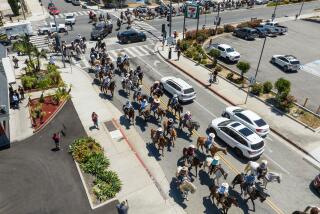Filling These Shoes No Easy Job
Kelly Carle was crouching under a horse, nailing a shoe to its hoof, when it happened.
The space shuttle roared overhead, creating a sonic boom that startled the 1,100-pound animal. The horse kicked Carle, sending him flying. Although Carle suffered cuts and bruises, those were just minor injuries for a man who’s had his ribs broken and toenails sheared by the animals he works with every day.
“Anything can send these horses into a kick,” said Carle, 48, of Oxnard. “I’ve seen them miss my head and kick a 2-by-4 in half.”
Such is the life of a farrier, a person who travels from farm to farm and ranch to ranch, shoeing everything from old mares to young Arabian show horses.
They often work from the backs of pickup trucks, using hammer, anvil and forge to make the shoes red-hot and pliable. They endure sun, dust, flies and the inherent dangers of working with animals known to spook easily.
They do it for a variety of reasons: they enjoy working outdoors, they like being their own bosses, or they simply love helping lame horses walk again. But the job involves more than just nailing on a shoe. Farriers must know the anatomy of a horse and how its mind works.
“It’s just like being a medical doctor,” said Ralph Casey, president of the Brotherhood of the Working Farriers Assn., a trade organization based in Lafayette, Ga.
“You have to constantly continue educating yourself. You have to study new methods and techniques. You are working on a live animal, and you’re working on the part that is going to keep the horse sound.”
The craft allows horses to walk, run or trot on just about any surface without wearing down their hooves and going lame. It’s been around since before the birth of Christ and is likely to continue, particularly in California, which has a horse population of 642,000--second-highest behind Texas, according to the American Horse Council.
But the job isn’t for everyone. In Ventura County, many farriers work 12-hour days, sometimes arriving before dawn. They often get nipped, pawed and pooped on, and suffer chronic back problems from having to crouch and bend all day.
Darrell Rice, 44, of Somis has been shoeing horses since he was 16. He loves being able to work outside, but the job has started to take a toll on his back.
“After 20 years, you start to have problems,” Rice said. “Each year it gets a little stiffer, and each time you stand up, it takes a little longer.”
Farriers shoe an average of six to 10 horses a day, charging anywhere from $75 to $100 or more per horse. Some went to school to learn their skill; others started as apprentices.
Jim Parchman, 61, a retired astrophysicist from Newbury Park, taught himself the trade 23 years ago, after his own farrier moved away. Parchman started off shoeing his own horses, then eventually developed a steady client base.
On a recent morning, Parchman was called to shoe Tez, a 15-year-old mare with inflamed hooves.
He pulled his pickup up to her pen, carefully pried off her old shoes, dug out the impacted mud, then filed and trimmed each hoof into shape, making sure it was level and uniform. He applied a therapeutic pad and proceeded to mold a set of shoes for her hooves. He heated each metal shoe in a forge until it was red-hot, then pounded it into shape against his anvil. He cooled them in a bucket of water before nailing them in place.
“People look at this as taking a piece of steel and slapping it on a horse’s hoof,” said Parchman, as he wiped the sweat from his brow. “There’s a lot going on behind the scenes.”
Carle had a more urgent task that day.
Daiquiri, a 7-year-old Arabian show horse, had pulled off her shoe just days before a big competition, tearing off a section of her front hoof. Carle was asked to reconstruct it--pronto.
After rebuilding Daiquiri’s hoof with acrylic, he fashioned a set of shoes to enhance her gait and correct her bowlegged hind legs.
“I get immense satisfaction in being able to see a lame horse walk away, or seeing a little kid get to ride again,” Carle said. “Animals can’t talk, but you can see it in their eyes when the pain goes away, when they can walk again or jump again.”
More to Read
Sign up for Essential California
The most important California stories and recommendations in your inbox every morning.
You may occasionally receive promotional content from the Los Angeles Times.










